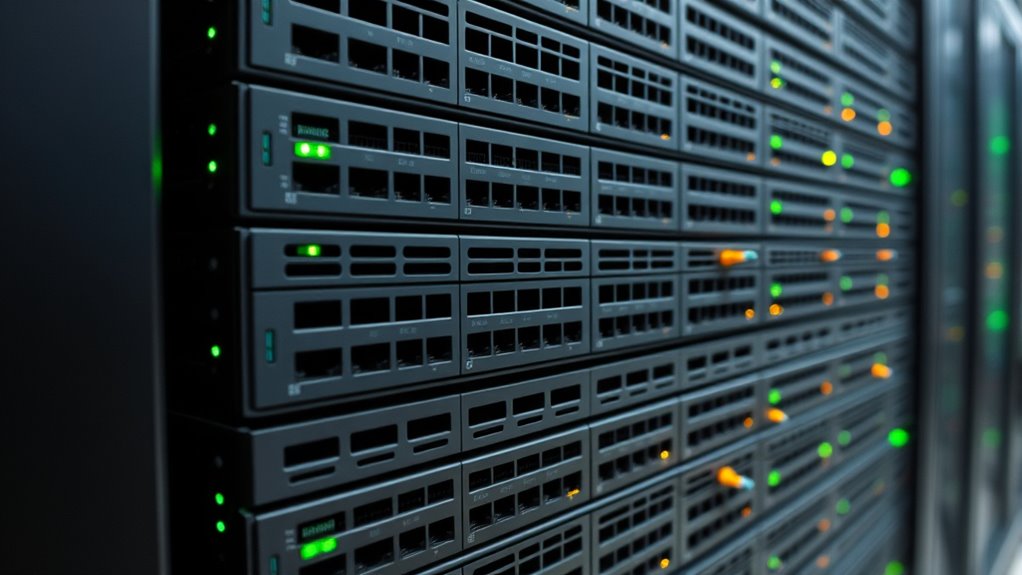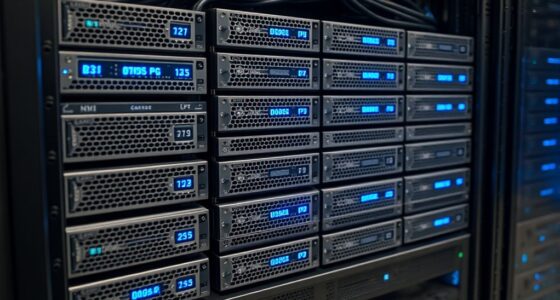If you want seamless connectivity in 2025, I recommend considering stackable switches with high port counts, multi-Gigabit speeds, and PoE support. I focus on options like the 18-port 2.5G switch, D-Link’s 28-port model, or managed switches like HP’s stackable series for scalability. Durability and easy setup matter too. Keep these factors in mind—if you continue, you’ll discover the top options tailored for future-proof networks.
Key Takeaways
- Prioritize switches with high port density, including multi-Gigabit options, for scalable and future-proof network expansion.
- Choose stackable switches with management features for seamless configuration, monitoring, and centralized control.
- Consider physical durability and industrial-grade designs for reliable performance in harsh or demanding environments.
- Ensure PoE support and ample power budget for powering IP cameras, Wi-Fi access points, and other PoE devices.
- Evaluate warranty, after-sales support, and overall value to maintain long-term network stability and performance.
18 Port 2.5Gb Ethernet Switch with 16* 2.5G Ports and 2* 10G SFP+ Ports

If you’re looking for a high-speed, reliable switch for small to medium-sized networks, the 18 Port 2.5Gb Ethernet Switch with 16 2.5G ports and 2 10G SFP+ ports is an excellent choice. It features 16 auto-negotiating 2.5G RJ45 ports supporting IEEE802.3bz, plus 2 SFP+ ports for fiber uplinks. With a switching capacity of 120 Gbps and transfer speeds up to 2.5 Gbps per port, it handles multiple devices smoothly. Its fanless, compact design guarantees silent operation, perfect for offices, homes, or small businesses. Easy plug-and-play setup makes deployment quick, while its robust build guarantees consistent, high-speed performance.
Best For: small to medium-sized networks such as offices, homes, or small businesses seeking high-speed, reliable connectivity with future-proof fiber uplink options.
Pros:
- Supports up to 120 Gbps switching capacity with transfer rates up to 2.5 Gbps per port, ensuring smooth multi-device performance.
- Fanless, compact design provides silent operation and easy placement in various environments.
- Plug-and-play setup with auto-negotiation and auto-MDI/MDIX ports simplifies deployment without configuration.
Cons:
- Some users report ports can get hot during extended use, potentially affecting longevity.
- Occasional issues with overheating or connectivity drops in certain setups.
- Reports of receiving used items or experiencing minor hardware inconsistencies from some customers.
Mini 10 Ports PoE+ Gigabit Ethernet Switch

The Mini 10 Ports PoE+ Gigabit Ethernet Switch is an ideal choice for industrial environments that demand reliable, high-speed connectivity with PoE capabilities. It features 8 PoE+ ports and 2 uplink ports, supporting data transfer speeds up to 1 Gbps. With a maximum PoE power output of 240W, it can power multiple devices like IP cameras and WiFi access points directly over Ethernet. Built with a rugged metal case and IP40 rating, it’s dustproof and durable, operating reliably in harsh conditions from -40°F to 176°F. Its compact design makes installation via DIN rail or wall mounting straightforward, perfect for limited or industrial spaces.
Best For: industrial and professional environments requiring reliable, high-speed PoE network connections for IP cameras, WiFi access points, and other PoE-enabled devices.
Pros:
- Rugged metal construction with IP40 rating ensures durability in harsh conditions.
- Supports up to 240W PoE power, capable of powering multiple devices simultaneously.
- Plug-and-play setup with gigabit speeds on all ports for seamless high-performance connectivity.
Cons:
- As an unmanaged switch, it lacks advanced configuration and management features.
- Limited to 10 ports, which may not suit larger network expansions.
- No included power supply, requiring compatible power input for operation.
TP-Link TL-SG105 5-Port Gigabit Ethernet Switch
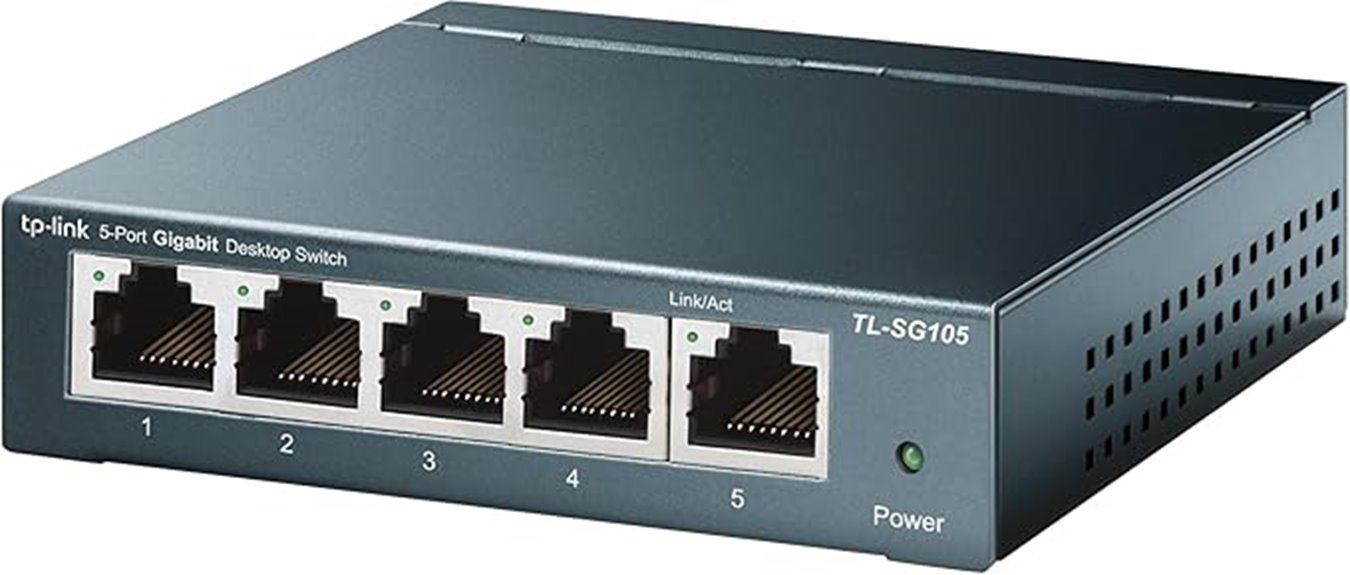
The TP-Link TL-SG105 5-Port Gigabit Ethernet Switch stands out as an ideal choice for small offices or home networks seeking simple, reliable expansion. Its durable metal casing guarantees longevity, while the fanless design keeps operation silent. With five auto-negotiating Gigabit ports, it easily supports high-speed connections without complex setup, thanks to its plug-and-play feature. Energy-efficient and eco-friendly, it reduces power consumption while handling increased network traffic. The switch also offers advanced traffic management with QoS and IGMP Snooping, guaranteeing smooth video and voice data. Backed by a three-year warranty and technical support, it’s a dependable, straightforward solution for expanding your network seamlessly.
Best For: small offices or home networks seeking a reliable, easy-to-use switch for expanding high-speed Ethernet connections.
Pros:
- Durable metal casing with fanless, silent operation for versatile placement
- Plug-and-play setup with auto-negotiation and auto MDI/MDIX ports for hassle-free connectivity
- Energy-efficient technology reduces power consumption while supporting high traffic
Cons:
- Limited to 5 ports, which may not suit larger network expansions
- Lacks managed features for advanced network configurations
- No built-in security features beyond basic QoS and IGMP Snooping
TP-Link 8 Port Gigabit Ethernet Network Switch

With its sturdy metal casing and fanless design, the TP-Link 8 Port Gigabit Ethernet Network Switch offers reliable, silent operation ideal for small to medium-sized offices or home setups. Its robust construction guarantees durability, heat dissipation, and EMI protection, making it a long-lasting choice. The switch features eight 10/100/1000 Mbps ports with auto-negotiation and auto MDI/MDIX, enabling quick, plug-and-play setup without software. Energy-efficient technology reduces power consumption, cutting costs. Additional features like IEEE 802.3x flow control and a loop prevention button enhance network stability. Support for QoS and IGMP Snooping ensures supreme traffic management for high-quality video and voice transmission.
Best For: small to medium-sized offices or home networks seeking reliable, high-performance wired connectivity with easy setup and energy efficiency.
Pros:
- Durable metal casing with heat dissipation and EMI protection for long-lasting use
- Fanless design ensures silent operation and enhanced thermal efficiency
- Supports advanced traffic management features like QoS and IGMP Snooping for high-quality data transmission
Cons:
- Limited to 8 ports, which may not suffice for larger network expansions
- No included management software, so advanced configuration options are limited to basic features
- Lacks Power over Ethernet (PoE) support, restricting direct powering of connected devices
NETGEAR 5-Port Gigabit Ethernet Switch (GS305)
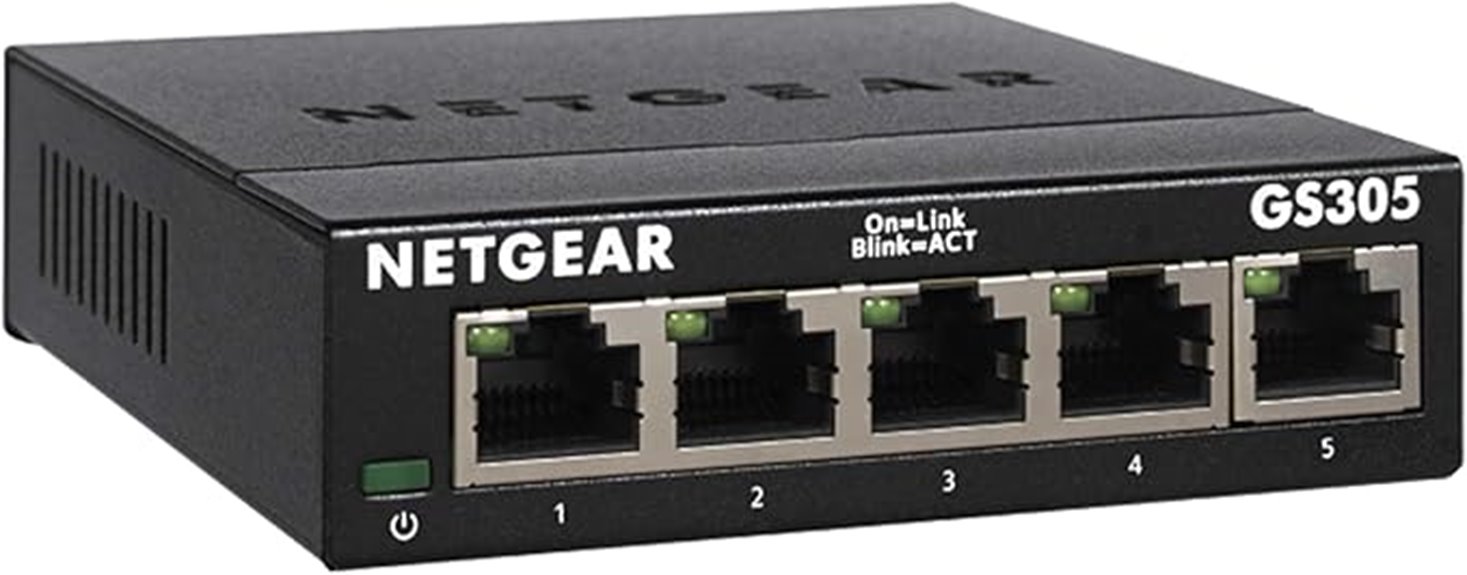
If you’re looking to expand your small office or home network reliably, the NETGEAR GS305 stands out as an excellent choice because it offers five gigabit ports in a compact, durable design. Its rugged metal case and lightweight build make it easy to place anywhere, whether on a desk or mounted on a wall. With plug-and-play setup, auto MDI/MDI, and energy-efficient technology, it delivers fast, stable gigabit speeds with minimal fuss. The silent, fanless operation guarantees noise-free use in quiet environments. Overall, the GS305 is a dependable, straightforward solution for increasing wired connectivity without managed switch complexities.
Best For: small office or home users seeking a reliable, easy-to-use switch to expand wired network connectivity without managed switch complexities.
Pros:
- Easy plug-and-play setup with auto MDI/MDI and auto negotiation
- Quiet, fanless operation suitable for noise-sensitive environments
- Durable metal case with compact design for versatile placement
Cons:
- Limited to five ports, which may not suffice for larger networks
- No advanced management features or configurable settings
- Compatible primarily with U.S. and CA electrical standards, not suitable for UK outlets
16 Port Gigabit PoE Switch (Unmanaged, 16 PoE+ Ports, 240W, Uplink & SFP Slots)

A Port Gigabit PoE Switch with 16 PoE+ ports is an excellent choice for small businesses or remote setups that need reliable power and data connectivity without complex configuration. It supports IEEE 802.3at/af standards, delivering up to 30W per port and a total of 240W. With 2 gigabit uplink ports and an SFP slot, it offers flexible network expansion. Its fanless, durable metal design guarantees silent operation, suitable for offices or remote locations. Plug-and-play setup makes installation straightforward, while its compact size and mounting options provide versatile deployment. Overall, it’s a dependable, efficient solution for powering devices like cameras, access points, and printers.
Best For: small businesses, remote offices, or home networks requiring reliable, high-power PoE connectivity without complex setup.
Pros:
- Easy plug-and-play installation with no configuration needed
- Silent, fanless design suitable for quiet environments
- Supports up to 30W per port with a total of 240W power budget, ideal for powering multiple PoE devices
Cons:
- No included Ethernet cables, requiring additional purchase
- Minimal instructions, especially regarding DIP switch functions
- No rack-mount ears included, which may limit mounting options for some users
NETGEAR 8-Port Gigabit Ethernet Unmanaged Switch

The NETGEAR GS308 8-port Gigabit Ethernet unmanaged switch is an ideal choice for small offices or home networks that need reliable, plug-and-play expansion. Its rugged metal case guarantees durability, while the compact design makes it easy to mount or place on a desk. With 1 Gbps speeds on each port, it delivers consistent, fast connections without dropouts. The fanless design guarantees silent operation, perfect for noise-sensitive environments. Setup is straightforward—just plug in Ethernet cables, and you’re ready to go. Its energy-efficient IEEE802.3az compliance helps save power, making it a reliable, durable, and simple solution for expanding your network seamlessly.
Best For: small home or office users seeking a reliable, easy-to-use network switch to expand their wired connections without complex setup.
Pros:
- Plug-and-play setup with no configuration required
- Durable metal case and silent fanless operation for longevity and quiet environment
- Supports 1 Gbps speeds on all ports for fast, consistent data transfer
Cons:
- Lacks advanced management features like VLAN or QoS controls
- No Power over Ethernet (PoE) support for powering devices
- May require additional switches or managed models for complex network configurations
HPE Networking Instant On 1960 12-Port 10Gb Switch (JL805A#ABA)

Designed for growing businesses, the HPE Networking Instant On 1960 12-Port 10Gb Switch stands out with its high-performance 12x 10GBase-T ports and four SFP+ uplink ports, making it ideal for expanding networks that require fast, reliable connectivity. With 16 active ports supporting high-bandwidth applications and high-density deployments, it serves well as a core switch. Its stackable design allows up to four switches to be combined, simplifying management. Easy setup via the mobile app or web browser, along with features like local and cloud management, ensures quick deployment. Plus, its durable, rack-mountable design and industry-leading warranty make it a dependable choice for future-proof networking.
Best For: growing businesses seeking a high-performance, stackable Ethernet switch with easy management and future-proof connectivity.
Pros:
- Supports high-density deployments with 16 active ports, including 12x 10GBase-T and 4 SFP+ uplinks
- Simple setup and management via mobile app or web browser with cloud and local stacking options
- Durable, rack-mountable design with industry-leading lifetime warranty for reliable operation
Cons:
- Limited to Layer 2+ features, which may not suffice for advanced routing needs
- No built-in PoE support, restricting power options for connected devices
- May require additional switches for larger network expansion beyond four units
D-Link 28-Port Gigabit Managed PoE+ Switch (DGS-1510-28P)

If you’re looking to expand a small to medium-sized network with high-speed connectivity and PoE+ support, the D-Link DGS-1510-28P stands out as an excellent choice. It offers 24 Gigabit PoE+ ports with a total power budget of 193W, ideal for powering IP cameras, VoIP phones, and other PoE devices. The switch includes two 10GbE SFP+ ports and fiber SFP interfaces, providing scalable uplinks. Its smart managed design features web-based management, CLI, and Layer 3 Lite routing, making setup and maintenance straightforward. Compact and reliable, it’s perfect for SMBs, media centers, or home labs seeking high performance and flexible network expansion.
Best For: small to medium-sized businesses, media centers, or home labs seeking high-speed, PoE+ network expansion with reliable management features.
Pros:
- Supports 24 PoE+ ports with a total power budget of 193W, ideal for powering multiple PoE devices.
- Includes two 10GbE SFP+ ports and fiber interfaces for scalable uplinks and high-bandwidth applications.
- Web-based management with CLI and Layer 3 Lite routing simplifies setup, monitoring, and network segmentation.
Cons:
- Lacks enterprise-level redundancy features such as dual power supplies or backplane stacking.
- Some users report PoE stability issues requiring firmware updates or hardware adjustments.
- Documentation can be inconsistent, potentially leading to a longer learning curve for advanced configurations.
UGREEN 5-Port Gigabit Ethernet Switch

For anyone seeking a reliable, plug-and-play Ethernet switch, the UGREEN 5-Port Gigabit Ethernet Switch stands out as an excellent choice. Its compact, fanless design makes it perfect for small spaces, whether on a desk or wall-mounted. Supporting 10/100/1000 Mbps speeds and auto MDI/MDIX, it ensures fast, stable connections across multiple devices like computers, gaming consoles, or streaming devices. No drivers needed, and it’s compatible with various operating systems. Its energy-efficient, silent operation and sturdy metal build add to its appeal. Customers praise its quick setup, reliable performance, and affordability, making it a practical, versatile choice for home or office network expansion.
Best For: home users, gamers, and small office setups seeking an easy-to-use, reliable, and compact Ethernet switch for high-speed network expansion.
Pros:
- Supports gigabit speeds (10/100/1000 Mbps) for fast, stable connections
- Plug-and-play setup with no drivers required, compatible across multiple OS
- Quiet, fanless design with sturdy metal construction for durability and silent operation
Cons:
- No Power over Ethernet (PoE) support for powering devices through Ethernet cables
- Limited to 5 ports, which may not be sufficient for larger network setups
- Powered via AC adapter, no USB-C or alternative power options
6-Port 10G/2.5G Ethernet Switch with Dual 10GBASE-T
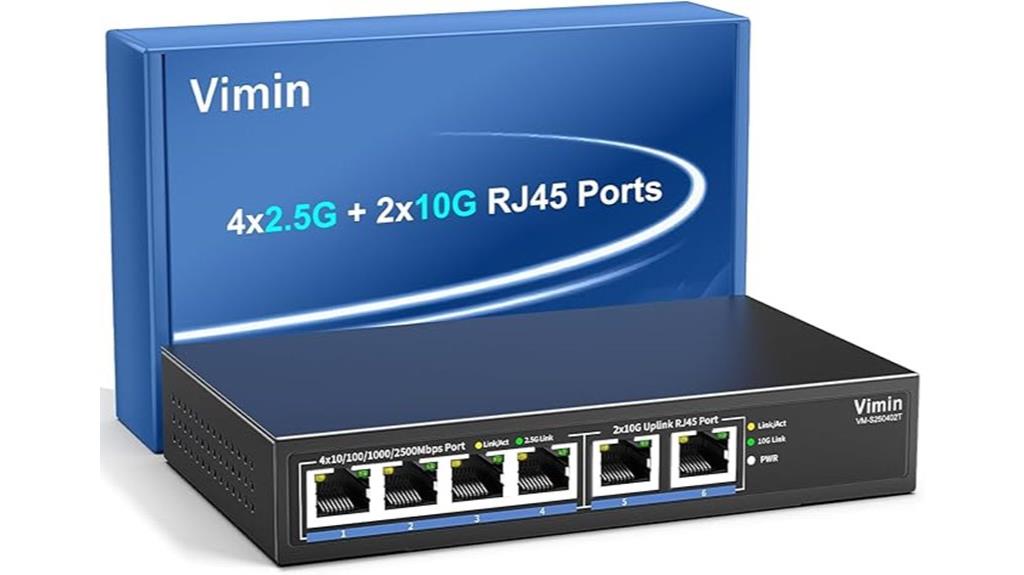
The Port 10G/2.5G Ethernet Switch with Dual 10GBASE-T is an excellent choice for users needing high-speed, reliable connectivity in compact spaces. It features 6 ports, including dual 10GBASE-T and four 2.5G ports, supporting auto-negotiation up to 10/100/1000/2500 Mbps. With a non-blocking 60Gbps capacity, it handles demanding tasks like 4K streaming, gaming, and data transfers effortlessly. Its plug-and-play design, metal case, and fanless operation make it durable, quiet, and easy to deploy. Perfect for home, professional, or travel use, it offers future-proof scalability and solid performance at an affordable price.
Best For: users seeking a compact, high-speed Ethernet switch for seamless home, professional, or portable networking with future-proof scalability.
Pros:
- Supports dual 10GBASE-T and 2.5G ports for high-bandwidth applications and future expansion.
- Durable metal case and fanless design ensure quiet operation and long-lasting performance.
- Plug-and-play setup with auto-negotiation and LED indicators for quick, hassle-free deployment.
Cons:
- Lacks USB-C power support, limiting compatibility with newer power sources.
- Shorter power cords may require additional extension cables.
- Occasional hardware issues reported, such as power loss or rattling parts.
HP Procurve 2615-8-PoE Stackable Ethernet Switch (J9565A#ABA)

Designed for small to medium-sized networks, the HP Procurve 2615-8-PoE Stackable Ethernet Switch stands out with its built-in Power over Ethernet (PoE) support on 8 ports, making it an ideal choice for environments that need to power devices like VoIP phones and wireless access points without additional power supplies. It features 10 ports, including 8 PoE-enabled ones, supporting 10/100/1000Base-T and 10/100Base-TX interfaces. The switch is manageable and supports stacking, allowing for expanded network management and scalability. With 2 expansion slots, it offers flexible connectivity options, ensuring reliable, seamless network integration for growing organizations.
Best For: small to medium-sized organizations seeking a manageable, scalable, and PoE-capable Ethernet switch for their network infrastructure.
Pros:
- Supports PoE on 8 ports, ideal for powering VoIP phones and wireless access points
- Stackable design enhances network management and scalability
- Equipped with 2 expansion slots for flexible connectivity options
Cons:
- Limited to 10 ports, which may be insufficient for very large networks
- No advanced Layer 3 routing capabilities included
- May require additional management tools for complex network configurations
D-Link 28-Port Gigabit Ethernet Switch

If you’re looking to expand your SMB network with high-performance, scalable connectivity, the D-Link 28-Port Gigabit Ethernet Switch is a top choice. It’s a next-generation, Layer 3 smart-managed switch with 24 Gigabit ports and four 10 Gbps ports for uplinks and stacking, supporting up to eight switches with 80 Gbps bandwidth. It offers advanced features like OSPF, RIP, IGMP, and PIM, making it ideal for complex networks. The switch supports Zero Touch Provisioning and multi-site management via Web GUI, ensuring easy deployment. Its high-speed connectivity and scalability make it perfect for growing SMBs seeking seamless, reliable network expansion.
Best For: SMBs seeking high-performance, scalable, and feature-rich network switches for complex and growing network environments.
Pros:
- Supports advanced Layer 3 routing protocols like OSPF, RIP, IGMP, and PIM, ideal for complex networks.
- Provides multi-Gigabit connectivity with 24 Gigabit ports and four 10 Gbps uplink/staking ports.
- Features Zero Touch Provisioning and multi-site Web GUI management for easy deployment and management.
Cons:
- May be overkill for very small or simple network setups requiring basic switching.
- Slightly larger footprint with dimensions of 17.3 x 8.25 x 1.73 inches, which might require adequate space.
- The product’s weight of 2 kg could be a consideration for certain installation environments.
Factors to Consider When Choosing Stackable Network Switches
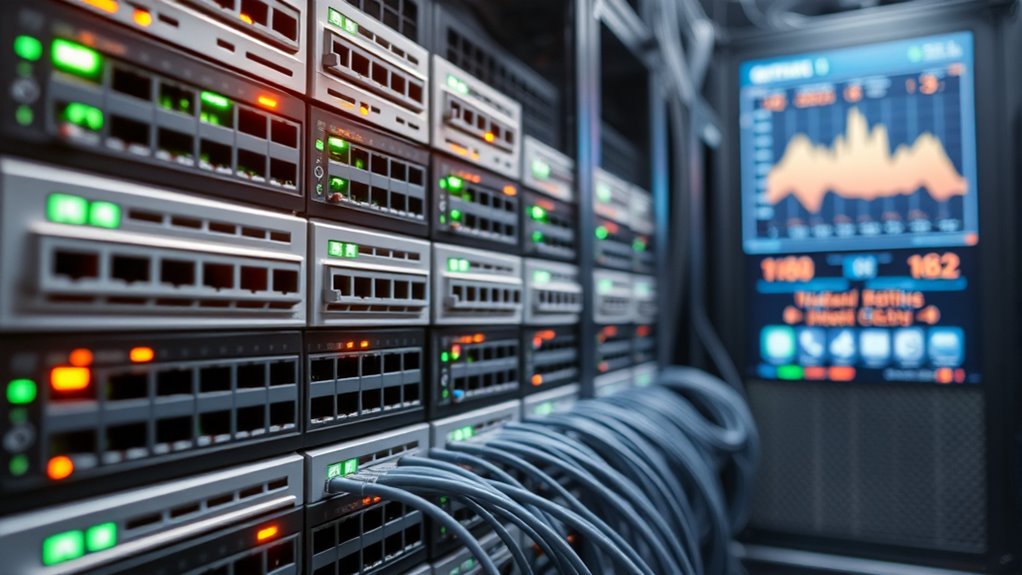
When selecting stackable switches, I focus on port count and types to guarantee they meet my network’s needs. I also consider management features and PoE support to simplify setup and power devices efficiently. Ultimately, I look at scalability options and physical durability to keep my network reliable as it grows.
Port Count and Types
The number and types of ports on a stackable switch are essential factors because they directly affect how many devices you can connect and the network’s overall performance. A higher port count allows for more direct connections, supporting network expansion. Common port types include Gigabit Ethernet, 2.5Gbps, 5Gbps, and 10Gbps, each offering different data transfer speeds suited to various needs. Many switches combine standard Ethernet ports with uplink or SFP/SFP+ ports, enabling fiber or high-speed connections. Multi-Gigabit ports, like 2.5G or 10G, future-proof your network and support higher bandwidth aggregation. Ultimately, the total port count and port types influence your network’s scalability, performance, and flexibility, making them critical factors when selecting a stackable switch.
Management Features
Management features are a key consideration because they determine how easily you can control and monitor your network. Managed stackable switches offer advanced options like VLAN setup, QoS, and SNMP monitoring, giving you greater visibility and control. These features simplify network administration, especially as your network grows. In contrast, unmanaged switches lack management capabilities, limiting your ability to segment traffic or prioritize data. With management support, switches often include web interfaces or CLI access, making configuration and troubleshooting more straightforward. Some switches also feature layer 3 management, enabling routing between VLANs and supporting complex network designs. Overall, management features are essential for scalability, security, and efficient operations, ensuring your network remains robust, flexible, and easy to maintain in evolving environments.
Power and PoE Support
Power and PoE support are vital factors to contemplate because they directly impact your network’s flexibility and device compatibility. I look for switches that support standards like IEEE 802.3af and 802.3at to guarantee my devices—such as IP cameras and access points—can be powered efficiently. It’s important to check the total PoE power budget so I know how many devices I can support without overloading the switch. For higher power needs, I consider PoE+ or PoE++ options, which deliver up to 30W, 60W, or even 90W per port. Additionally, I verify if the switch offers power redundancy features or advanced management capabilities like load balancing and fault tolerance. Compatibility with my power supply is also essential for reliable operation in my environment.
Scalability Options
Have you ever considered how easily your network can grow as your organization expands? Scalability options are vital when choosing stackable switches. Support for stacking multiple units via dedicated ports or virtual stacking technologies allows for expansion without a complete network redesign. Some models support up to eight or more switches, making them suitable for large enterprise environments. High-bandwidth stacking options, like 80 Gbps or more, prevent bottlenecks, ensuring smooth data flow as traffic increases. Flexibility in stacking protocols, whether physical or virtual, lets you tailor your network architecture to your evolving needs. Compatibility with various hardware modules, uplink options, and management features further simplifies seamless expansion, making scalability a key factor in future-proofing your network infrastructure.
Physical Durability
Choosing a stackable network switch with robust physical durability is essential for ensuring long-term reliable performance. The casing material plays a vital role; metal enclosures provide better impact resistance and wear durability compared to plastic. Ruggedized features like IP ratings, such as IP40, protect against dust and moisture, making them suitable for industrial or outdoor environments. The construction of internal components, including heat sinks and circuit boards, affects thermal resilience and the ability to operate continuously without failure. A sturdy chassis not only prevents damage during installation or maintenance but also withstands high-traffic conditions. Additionally, durability involves resistance to electrical surges and lightning strikes, with features like grounding, lightning protection, and surge suppressors extending the switch’s lifespan and ensuring consistent network performance.
Price and Warranty
Selecting a stackable network switch requires careful consideration of both price and warranty to guarantee long-term value. Higher-end models with advanced features usually cost more but can offer better durability and future-proofing, making them a smarter investment. It’s essential to review the warranty length and coverage details; multi-year or lifetime warranties provide better protection and support, reducing unexpected costs. Check if the warranty includes on-site service, replacement parts, or technical support, as these can minimize downtime and repair expenses. Be cautious with budget switches that often have limited warranties covering only manufacturing defects, which might impact reliability. Additionally, consider the manufacturer’s reputation for customer service and warranty claims processing, since a responsive provider guarantees smoother issue resolution over the switch’s lifespan.
Frequently Asked Questions
How Do Stackable Switches Improve Network Scalability?
Stackable switches improve network scalability by allowing me to connect multiple switches into a single logical unit. This setup simplifies management, reduces cabling clutter, and enables easy expansion as my network grows. When I need more ports or better performance, I just add or upgrade switches within the stack. This flexibility guarantees my network remains efficient, adaptable, and ready to handle increased traffic without major disruptions.
What Are the Energy Efficiency Benefits of Stackable Switches?
Imagine upgrading your office network and noticing a significant drop in energy bills—that’s the power of energy-efficient stackable switches. These switches optimize power use by adjusting energy based on data traffic and connected devices. For example, a mid-sized company reduced energy consumption by 30% after switching. I find that their ability to conserve energy not only lowers costs but also supports eco-friendly practices, making them a smart choice.
Can Stackable Switches Support Advanced Network Security Features?
Yes, stackable switches can support advanced network security features. I’ve seen them implement capabilities like VLAN segmentation, access control lists, and port security to protect data and prevent unauthorized access. Many modern models also offer features like integrated threat detection and network monitoring. By choosing the right stackable switches, I can guarantee my network remains secure, scalable, and adaptable to evolving security threats.
How Does Switch Stacking Affect Network Redundancy and Fault Tolerance?
Did you know that network downtime costs businesses up to $5,600 per minute? Switch stacking greatly improves redundancy and fault tolerance by creating a unified, resilient network. When one switch fails, traffic seamlessly reroutes through others, ensuring continuous connectivity. This setup minimizes disruptions, enhances reliability, and simplifies management—making your network more robust against failures. I’ve seen it transform the stability of business networks, keeping operations smooth even during hardware issues.
Are There Compatibility Concerns When Integrating Different Brands of Stackable Switches?
Yes, compatibility can be a concern when integrating different brands of stackable switches. I’ve found that brands often use proprietary protocols, which might prevent seamless stacking or cause management issues. To avoid headaches, I recommend sticking with the same brand or checking if the switches support standard protocols like OpenFlow or IEEE standards. Doing thorough research beforehand guarantees your network remains stable and easy to manage.
Conclusion
In wrapping up, choosing the perfect stackable switch depends on your needs, network size, and future growth. Consider capacity, compatibility, and cost to craft a custom connection. With these factors in mind, you’ll find a fantastic, flexible, and functional fit—fueling seamless, swift, and stable networking success. So, step confidently into a connected future, and select the switch that suits your space, speed, and style. Your ideal network awaits!
